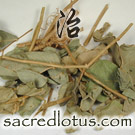Jin Qian Cao (Lysimachia)
Herb 20 of 28 in Herbs that Regulate Water and Drain Dampness
Buy This Herb
Get free shipping from
our partners at CHD
our partners at CHD
Chinese Herb Actions
-
Promotes Urination, Unblocks Stones, Clears Damp Heat
A very important herb for urinary bladder stones and kidney stones. For painful urination with dribbling with Damp Heat signs. - Clears Liver and Gallbladder Damp Heat, Unblocks Stones
For gallstones, jaundice with red swollen eyes, hepatitis with signs of Damp Heat - Clears Heat and Toxins, Reduces Swelling
For swellings, sores, lesions, abscesses, trauma, and snake bites apply this herb topically.
Chinese Herb Contraindications & Cautions
- Use with caution for Spleen Deficiency diarrhea.
Herb-Drug Interactions
- Due to Jin Qian Cao’s diuretic affect, use caution in patients taking diuretics.
Chinese Herb Toxicity & Overdose
- Rarely allergic reactions have been noted after overdose with signs redness and rash
- Section not completed...
Chinese Herb Dosage
- 15-30 grams in decoction with a maximum dose of 60 grams 12
- 15-30 grams in decoction 13
Chinese Herb Notes
- This herb is among the best at expelling stones and clearing toxins. Like Hai Jin Sha, it can promote urination, unblock stones and clear heat, but Jin Qian Cao goes to the root by clearing Damp Heat from the Liver and Gallbladder while Hai Jin Sha works on the small intestine and urinary bladder.
Chinese Herb Clinical Studies & Research
- Studies on the antilipid peroxidation of nine sorts of Chinese herbal medicines with the function of protecting liver
Jiang H, Huang X, Yang Y, Zhang Q. Zhong Yao Cai. 1997 Dec;20(12):624-6. - Effects of aqueous extract in herba of Lysimachia christinae on hyperuricemia in mice
Wang HD, Ge F, Guo YS, Kong LD. Zhongguo Zhong Yao Za Zhi. 2002 Dec;27(12):939-41, 944.






